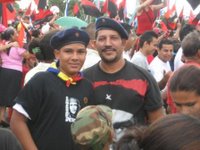Allan had his ninth birthday last week. Now, when I turned 9, I had a party with all of my friends from school. We all gathered in the backyard to play games such as red rover and capture the flag, and if I'm not mistaken there may have even been a scavenger hunt. So I was a bit surprised to find that Allan didn't have any friends over. Instead it was a family gathering. Uncles, aunts, cousins showed up to eat roasted chicken, rice and beans. Of course there was Coca-Cola to drink. And for desert we had delicious chocolate cake with lots of frosting that Allan's aunt smeared all over his face after he blew out the candles.
The traditional birthday song in much of Latin America is called "Las Mañanitas."
Las Mañanitas
Éstas son las mañanitas
Que cantaba el Rey David,
A las muchachas bonitas
Se las cantaba así.
Despierta, mi bien, despierta,
Mira que ya amaneció,
Ya los pajaritos cantan,
La luna ya se metió.
These are the morning verses
That King David used to sing,
To the beautiful young ladies,
He would sing them like this.
Wake up, darling, wake up,
Look, the dawn has broken,
The birds are singing,
The moon has already gone down.
When I was teaching in Mexico, the whole school would gather every Monday morning to sing this song to all of the children who had a birthday that week. I never really understood why they sing a song about King David on a child's birthday. Then today I did an internet search for Las Mañanitas and found that there's actually a third verse...
Éstas son las mañanitas
Que cantaba el Rey David,
Hoy por ser día de tu santo
Te las cantamos a ti.
These are the morning verses
That King David used to sing,
Today because it's your saint's day
We're singing them to you.
Now it makes more sense. Because back in the old days they didn't celebrate birthdays on the date on which you were born. Instead they celebrated the day that corresponds to the saint that is your namesake, which could be in an entirely different time of year.
And now, some cute birthday pictures:

The birthday boy smeared with frosting
Blowing out candles with Mom (Mari) and Brother (William)












 Giddy-Up!
Giddy-Up!
 Getting to Ometepe involved a two hour drive in Saul’s pickup truck from Managua to San Jorge, and then an hour-long ferry ride to the island. The trip was made ever the more difficult because Saul was bringing a large whiteboard to the Health Clinic on the island. The ferry from San Jorge arrives in the village of Moyogalpa, but the class was on the other side of the island in the town of Altagracia. Getting to Altagracia required a taxi, but finding a taxi that could take a large whiteboard was not so easy. Eventually we found a large van and were able to tie the board to the roof. Tying things to the roof of a vehicle is quite common practice here in Nicaragua
Getting to Ometepe involved a two hour drive in Saul’s pickup truck from Managua to San Jorge, and then an hour-long ferry ride to the island. The trip was made ever the more difficult because Saul was bringing a large whiteboard to the Health Clinic on the island. The ferry from San Jorge arrives in the village of Moyogalpa, but the class was on the other side of the island in the town of Altagracia. Getting to Altagracia required a taxi, but finding a taxi that could take a large whiteboard was not so easy. Eventually we found a large van and were able to tie the board to the roof. Tying things to the roof of a vehicle is quite common practice here in Nicaragua 


